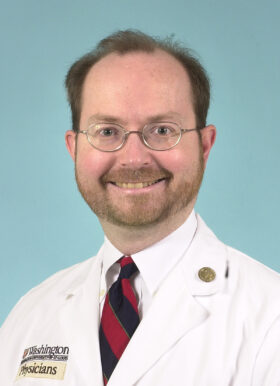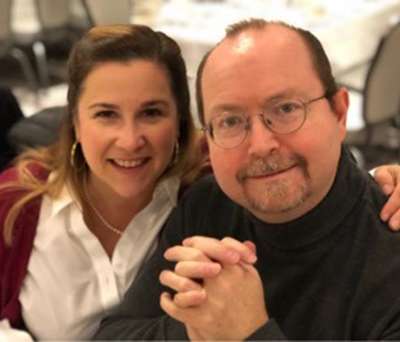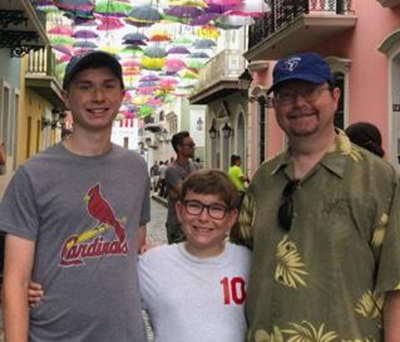John Kirby, MD

John Kirby, MD specializes in acute and critical care surgery, wound healing, burn/trauma/surgical critical care. His areas of clinical interest include necrotizing fasciitis, hyperbaric oxygen treatments, organ failure, sepsis and shock.
Dr. Kirby sees patients at:
- Barnes-Jewish Center for Outpatient Health, Ground floor, 4901 Forest Park Avenue, St. Louis, MO 63108
Please call 314-362-5298 for an appointment.
What happened in the course of schooling to influence you to choose your specialty?
Over the course of my general surgery residency and fellowship in surgical critical care, I developed an interest in patients with serious wounds and wounds that were not healing. This was a fascinating problem, especially as people are living longer and living with underlying health problems (such as diabetes, spinal cord injury, or other debilitating conditions) that don’t allow wounds to heal easily.
It became apparent if we could intervene like we do in the ICU, to get people over a healing challenge, the patients would heal in. I found that being able to help patients with this problem was very satisfying. Sure enough, as I pursued it, more interventions came to the forefront allowing people to heal wounds that previously would not heal.
What brought you to Washington University?
I came to Washington University and Barnes-Jewish Hospital in 2006 because Dr. Timothy Buchman, Dr. William Chapman, and Dr. Timothy Eberlein were expanding trauma, acute care surgery and critical care to encompass more difficult wounds and burn. They wanted to extend the capabilities of the department to do this as well as begin to bring in more advanced modalities such as hyperbaric oxygen therapy and telemedicine to accomplish this.

What is wound care?
Wound care is just that, practices to care for and heal a wide variety of wounds that a patient might have. We are fortunate here that we can accommodate a very wide spectrum of patients and their wounds. We treat critically ill inpatients with wounds that are infected to outpatients who have more chronic wound problems like diabetic foot ulcers or even extended care cancer patients with wounds.
Our team here is comprised of surgeons we are able to offer both surgical treatments and non-surgical treatments. Non-surgical procedures can be done in the doctor’s office where we debride the wound (remove unhealthy tissue to promote healing) or use special irrigation to clean the wound. Other treatments are commonly focused on restoring a patient’s blood flow and oxygenation to the wound so that the wound might heal.
What are reasons for a wound not to heal?
A wound might not heal for many reasons including poor blood flow, lack of adequate oxygen or nutrients to the wound, or on-going inflammation or infection. As we grow older, we tend to heal more slowly. When a wound doesn’t heal, it is usually due to a combination of several underlying medical conditions, such as poor blood flow, poor levels of oxygen or other nutrients, infection and inflammation, bone involvement and the cumulative effects of medical conditions like diabetes on the body.
Oftentimes when a patient comes to us for help, he or she has been receiving very good medical care, but the underlying medical conditions are too much for the body to heal in the wound. The patient needs something to stimulate the body to get over the period of non-healing. That something might be improving blood flow, improving the oxygen delivery to the wound, stimulating the wound with tissue cultures or quite simply cutting away the non-viable tissue in order to get the wound to close.
Which aspect of your practice do you find most interesting?
I enjoy the challenge of seeing patients who come to see me with a variety of problems. Working in an environment where we can offer treatment to our patients and help them is the reason I come into work every day.
What new developments in your field are you most excited about?
We continue to see improvements in our ability to use negative pressure (essentially a suction dressing) to close wounds, and manage heavily contaminated wounds with a combination of both irrigating wound and closing the tissue with that vacuum force.
It is fascinating to watch the evolution of better data that allows us to make more evidence-based decisions for different types of wounds.
We are also now realizing the potential that improving the patient’s blood flow and oxygenation could be used the help heal a wide variety of wounds.
Finally, basic science is always evolving in wound care by stimulating a patient’s own body tissues to heal in.

How do you go about improving blood flow and oxygenation?
We work very closely with our vascular surgeons. Our vascular surgery department here is one of the leaders in using the latest percutaneous techniques to improve blood flow to non-healing areas. Maintaining this arterial flow allows the tissue to heal in.
The hyperbaric oxygen chamber is used to manage wounds that haven’t had adequate blood flow for a period of time or have a condition that limits the body’s ability to heal in. Patients can develop a secondary wound that will not heal without the stimulatory effects of hyperbaric oxygen.
We are looking at how to fully harness the effects of the hyperbaric oxygen chamber by growing new blood vessels in injured areas (either as a result of diabetes or radiation), improving response to infection, and improving blood flow through the tissue.
This treatment stimulates new tissue and new blood vessels to grow in and we are beginning to see more successful results.
A typical outpatient hyperbaric treatment is about 90 minutes, five days a week. A typical treatment sequence could be anywhere between 20 and 40 treatments.
Where are you from?
My family and I lived in and around the New York City area until we moved to Chicago when I was in junior high. After high school I attended the University of Illinois for college, medical school, graduate school and my surgical residency. I came to Washington University and Barnes-Jewish Hospital in 2006, so I’ve been in the Midwest for almost three quarters of my life.
Which particular award or achievement is most gratifying?
One of the most satisfying components of my professional life has been my association with the Wendi Gordon Shelist NF Foundation to improve wound healing here at Barnes and nationally. It is a charitable not-for-profit foundation to educate the public and hospital medical personnel about necrotizing fasciitis (NF) and other serious wound healing problems.
Wendi Gordon Shelist was diagnosed with a life and limb threatening case of NF, also known as the “flesh-eating disease.” One day she was a healthy jogger, the next day she was critically ill. If not diagnosed and treated promptly, the disease can kill or maim very quickly. Wendi beat the odds and survived after multiple surgeries but it was a coordinated team approach, which is what has been built here, saved her life and her leg. She is a remarkable woman to have persevered through all of this, recover, and then give back through her foundation. I was and am privileged to work in this field and with her and her family.
The foundation’s mission “is to do everything possible to prevent this horrific disease from ever being misdiagnosed and to help educate the public.”
Wendi and her family wanted to do their part to help others affected by this terrible disease. Working with the foundation and receiving recognition from the family has been extremely gratifying.
How does necrotizing fasciitis happen?
It can be from any cut or break in the skin that gets infected and sometimes even uncut tissues can pick up this infection. Most of the time, an infected cut can be drained or treated with antibiotics. But in some cases, a subset of the bacteria has genetic enzymes that causes the tissue to die, or necrose, and break down.
This infection thrives underneath the surface of the skin and is particularly treacherous because the surface skin may look entirely normal even while the patient is worsening. This means getting the patient timely and aggressive treatment may be difficult. The infection can spread rapidly, putting the patient at great risk for becoming very sick very quickly and it may require surgically cutting away a large amount of tissue to get it under control, even with good care and antibiotics.
What is the best advice you’ve received?
The best advice is do what you love, always do the right thing, learn how to take care of a wide variety of patients and their problems, and choose the path that excites you most. Whatever keeps you up late thinking and whatever brings you into the office, lab or clinic early in the morning.
I’ve been very lucky to watch extremely advanced and talented people pursue their careers because they have followed those four caveats.
If you weren’t a doctor, what would you like to be doing?
It’s hard for me to picture doing anything else because I love this so much. But if I wasn’t a doctor, I’m sure I would be doing something that allowed me to work with people and be creative.
Being a surgeon is a phenomenal privilege. Every day I get the opportunity to advance the art of science and have an impact on my patients. I can’t imagine doing anything else as satisfying as that.